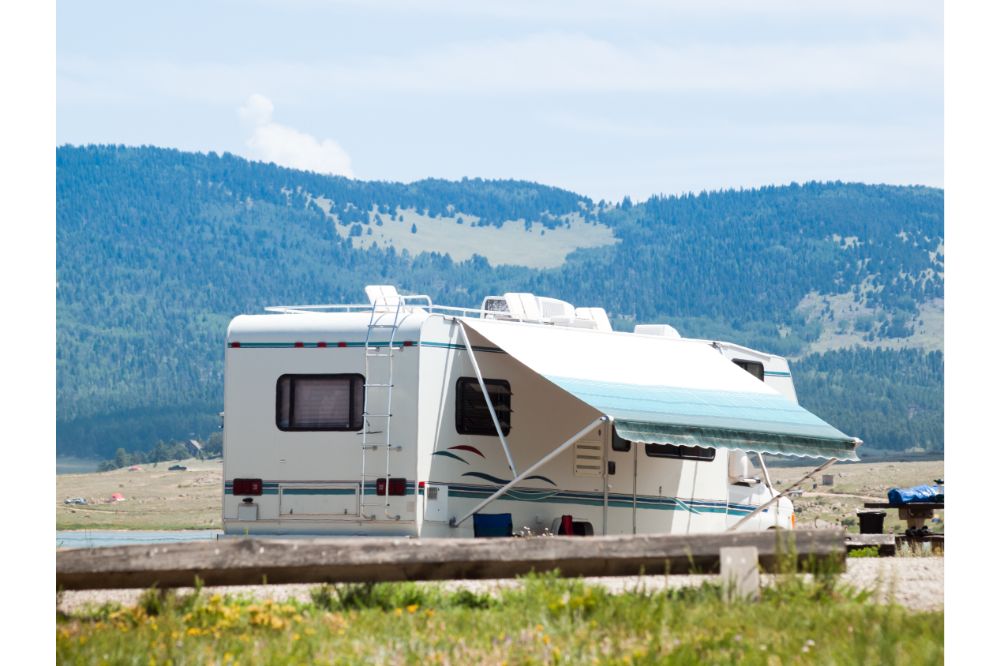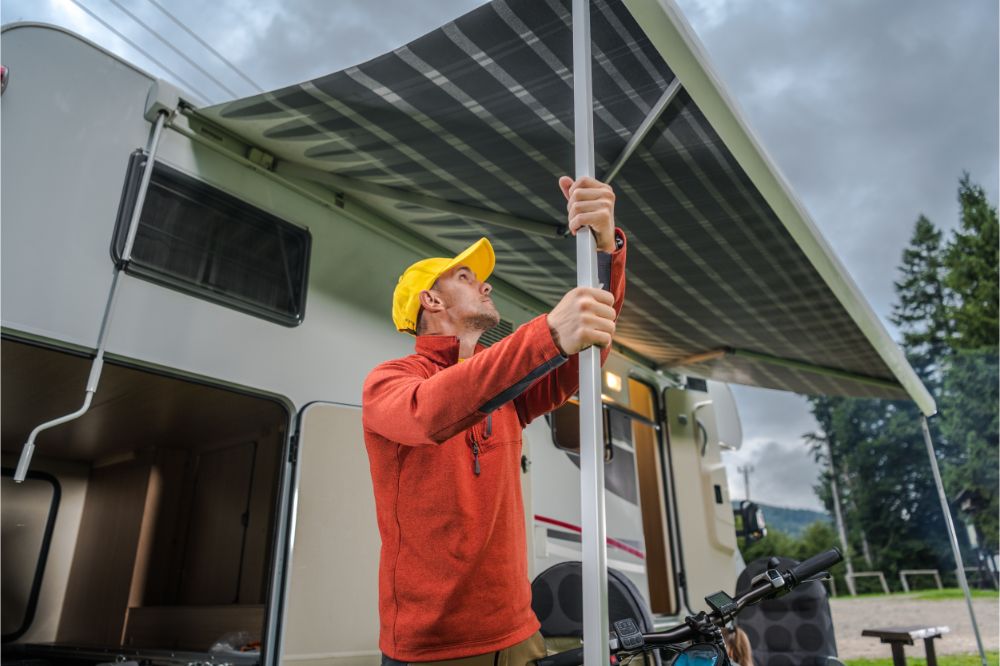Published Date: March 7, 2022
Last Updated on March 7, 2023 by Camper Front
Whether it’s severe weather or just a windy day, any RV owner knows that a flapping RV awning is the worst. Awnings serve a variety of purposes, from power awnings to patio awnings. The awning design can keep rain, sun, and heat away from your RV, keeping the inside cool during the summer.
Awnings for RV patios also help increase the amount of space that you can use around the outside of your RV, including dining spaces or just a shaded place to hang out and enjoy nature.
Let’s take a look at how to best keep an RV awning from flapping around with some tried and true DIY tricks and other methods.
Before severe weather or strong wind hits, you want to be sure that you’re pulling your RV awning in. Taking the best care of your awning includes keeping an eye on holes, rips, and tears caused by strong wind and wind gusts. Here we will look at how to keep RV awning from flapping. Let’s get to it!
Table of Contents
The DIY Methods
Let’s take a look at some ways to keep your awning from flapping in the wind without having to spend money on a product. There are some great DIY tricks that avid RV campers use to keep their awnings secure through all kinds of weather.
Bungee Cords
When it comes to keeping your RV awning from flapping all over the place, especially an electrical awning, try using a bungee cord. Using one bungee cord on either side, install the metal hooks into the side and bring them up to the arm notch.
You can then connect the cord to the ground by way of a screw-in auger. Ensure the strap has some yield to it; otherwise, you risk damaging your roller.
RV Awning Tape
Sometimes, getting back to the basics is all you need, in the form of some good old-fashioned tape. If your awning is flapping due to rips, punctures, or holes, you can fix it up with a strong tape made for delicate awning fabric. This type of tape can also be used to secure your awning so that the winds don’t send it flapping.
DIY RV Awning Tie-Down: Step by Step
If you’re not in the budget to buy a stabilizer kit or other anti-flapping kits, but you do have some camping gear laying around, then you might benefit from a specific DIY step-by-step. One of our favorite DIY step-by-step tie-down methods for your RV awning is here.
What you’ll need:
- 1/8-inch nylon rope and bungees
- Large CamRings and carabiners
- Stakes
Step 1
Hammer your stakes into the ground under the outside corners of your awning arms. Next, make sure to tighten the tension in the awning’s arms on both sides so that they’re as stable as possible.
Step 2
Using your bungees, carefully hang them over the corners of the awning structure between the awning fabric and the arm of the awning. Make sure that both bungee hooks are even on either side.
Step 3
Now it is time to cut your nylon rope to the appropriate size. The length needed will vary depending on how high your awning is from the ground. Once the rope is cut, tie one end to a carabiner. The other end of the rope should run through the two holes on your large CamRing. Tie a knot at the end of the rope. Then, hang the carabiner to the ends of the nylon rope.
Step 4
Now your nylon rope is hanging down towards the stakes that you put in the ground earlier. The knotted end should be by the stakes. Run this end through the stakes. Next, run the rope through the notch in your large CamRing.
Step 5
The position of the CamRing should now allow you to adjust the tension of the rope up or down, allowing you to tighten your grip on your awning. It should help awning from flapping during windy conditions.

RV Products
If you’re not very handy or if the DIY way of doing things isn’t for you, you’re still in luck. RV campers have come up with various accessible and affordable fantastic camping products that can help you keep your awning fabric from flying all over the place.
Anti-Flap Kit
Thankfully, RV companies are fully aware that awning-flapping is always a risk, especially in strong winds. There has been a development of the anti-flap kit for just this reason. These kits come with two adjustable vertical metal support poles.
These heavy-duty poles are usually made from aluminum and come in pairs so that you can set them up on both the left and right sides of your awning. These anti-flap kids work great for electrical awnings, manual awnings, and even auto awnings. However, don’t forget to take down the poles when you pull in your awning!
De-Flapper
Much like the anti-flap kit, a de-flapper is a device that uses grippers in order to help keep your awning in place. However, it’s much less heavy-duty, much smaller, and considerably easier to carry around. These de-flappers are created with highly durable nylon and connect from the arm to the awning fabric to keep it from lifting and flapping.
The soft, non-marring grippers allow the RV awning to have added support during high winds and severe weather. The de-flapper method is perfect if you’re surprised by strong winds and aren’t able to pull your awning in.
Stabilizing Kit
Another method that RV owners or users may employ to keep your awning from flapping around is utilizing a stabilizing kit. These can add full coverage to your RV awning using durable nylon rope and corkscrew anchors that will work in multiple different types of soil, from hard earth to sand.
The included tension units in the stabilizing kit will allow you to secure the ropes and adjust the tension firmly. Like those found close to the ocean and shore, stronger winds might require more substantial tension than lighter winds.
Different Types of Awnings
Some awnings handle the wind better than others. Let’s take a quick look at the different types of RV awning fabrics and the different styles of awnings and deduce which stabilization method will work best.
Acrylic Awning
The acrylic awning is one of the most popular types of awnings. While it isn’t waterproof, it can handle quite substantial water and rain. It can also handle sun, heat, dust, dirt, and road grime quite well. In order to prevent fabric flapping, a de-flapper would be perfect for holding everything in place.
Vinyl Awning
Another fabric awning, the vinyl awning, is one of the most common types. However, this awning is water and rust-proof. Because it is fabric, it does have some chance of holding onto dirt and mold. It’s still very durable. A de-flapper to keep the fabric secure would work best.
Slide Out Awning
The slide-out awning is often used manually. Because it is a manual pull-out, it is a little less stable than its mechanical or automatic counterparts. DIY bungee cords would be a great low-budget option for stabilizing the upper poles of a slide-out awning during windy weather. These types of awnings risk water pooling during rainy days.
Automatic Awning
These are the most expensive awnings and also some of the most stable. With a touch of a button, you can pull your awning in or set it up. A stabilizing kit or anti-flap kit might work best for this type of awning, as the poles and rope will work best to keep the mechanics from moving in strong winds.
Patio Awning
Another type of awning design is otherwise known as a patio awning. Plenty of RVs come with this type of awning. It’s prevalent because it allows for there to be more space for you to do activities outside of your awning. This type of awning could benefit from de-flappers or stabilizing kits.
Frequently Asked Questions
Does rain or wind damage RV awnings?
A little bit of rain or wind won’t do much damage to your awning. However, damage, wear, and tear are inevitable, primarily when you use your RV often during troublesome weather. Heavy rain and strong winds can do damage to your awning, so it’s essential to keep maintenance up.
How much wind can an RV awning take?
Depending on the type of awning and the quality of the build, RV awnings can withstand a wide variety of wind speeds. However, electric awnings can generally withstand less wind than manual awnings. Most people found that an electrical awning could withstand wind speeds of up to 6 to 10 mph, while a manual awning could withstand wind speeds of up to 20 mph.
How long does an RV awning last?
Some people may never have to replace their RV awning. However, depending on how much you use it and how often it’s used in rough weather, your RV awning could last longer or shorter than others. In general, a good RV awning can last anywhere from 5 to 15 years. Using DIY methods or RV products designed to help keep your awning secure will ensure the longevity of your awning.
Conclusion
Whether you have an acrylic awning, a power awning, or a manual awning, there will always be a way to keep your awning from flapping in high winds. Weather can be so tricky for RV enthusiasts to deal with, but these DIY tricks and RV products can help make sure you don’t risk rips and tears to your awning canopy. Using a method to secure your awning during high winds will ensure that you don’t have to replace your awning as often.

